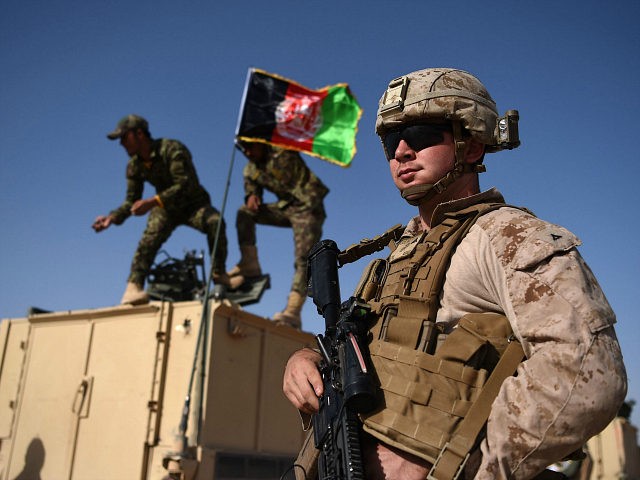WASHINGTON, DC – U.S. and Afghan forces targeted Taliban drug labs for the first time on Sunday in the first significant use of new authorities under the Trump administration, the top U.S. commander in Afghanistan said Monday.
A joint U.S.-Afghan force – flying B-52 bombers and F-22 fighters – struck seven Taliban drug laboratories and a command-and-control center in the southern Afghanistan province of Helmand, in districts controlled or contested by the Taliban.
The force also used drone-fired Hellfire missiles and U.S. Marine Corps-operated High-Mobility Rocket Systems (HIMARS).
“Last night, we conducted strikes into Northern Helmand to hit the Taliban where it hurts: their financing,” Army Lt. Gen. John Nicholson said in a statement.
“Increasingly, the Taliban have become a criminal organization. They fight, so they can keep profiting from their criminal activities: narco-trafficking, illegal mining, kidnapping and murder for hire,” he said.
"Last night, we conducted strikes into Northern Helmand to hit the Taliban where it hurts: their narcotics financing." -Gen. Nicholson, USFOR-A #AFGStrong https://t.co/RLjDdSYTlI @CENTCOM @USAFCENT @DeptofDefense @TOLOnews @pajhwok @HM_Kakar @1TVNewsAF @ArianaNews_ @KhalilNoori pic.twitter.com/152rTR236z
— USFOR-A Spokesman, Col Dave Butler (@USFOR_A) November 20, 2017
President Trump in August gave commanders in Afghanistan more authority to strike the Taliban and targets associated with its revenue stream, as well as allowed U.S. forces to advise and assist Afghan troops at a lower level closer to the battlefield. Trump also ordered about 3,000 more U.S. forces to advise and assist Afghan forces and got rid of any timelines for troop withdrawal.
Nicholson said at a Pentagon briefing on Monday that the new authorities “allowed us to attack the enemy across the depth and the breadth of the battlespace.”
The strikes against the Taliban’s drug labs are expected to continue, especially as U.S. forces wind down operations in Iraq and Syria and more resources are made available, Nicholson said.
The Taliban have more than 400 active drug labs where they process opium, he said. The Taliban is responsible for up to 85 percent of the world’s opium production, including four percent of heroin that makes its way to the U.S.
The plan is to continue hitting those processing centers versus hitting the poppy fields where the opium comes from, as civilian farmers and the Afghan population could be vulnerable. Opium is a major source of revenue for the Taliban, Nicholson said.
Currently, the Afghan government controls two-thirds of the population in Afghanistan, and the Taliban either controls or is contesting one-third. But 80 to 85 percent of the drug facilities are in areas controlled by the Taliban, he said.
Nicholson did not say whether any Taliban or civilians were killed in the strikes but said the coalition used the minimum size of bombs needed to destroy the facilities and avoid collateral damage, and the strikes came after hundreds of hours of surveillance of targets.
Nicholson said these targets have never been struck before.
“U.S. Forces – Afghanistan started developing targets immediately after the U.S. policy announcement this past summer that granted new authorities to the command,” he said. “This illustrates a shift in operations as USFOR-A attacks insurgent network economic lines in previously un-targeted safe havens in the South and Southwest.”
“This approach will not only weaken the Taliban’s financing and networks, but puts USFOR-A and [Afghan National Defense Security Forces] in an increasingly dominant position for continuing combat operations throughout the winter,” he said.
He added that, as India becomes more involved in Afghanistan’s economy per Trump’s plan, Afghans reliant on the opium trade will have other economic options.
Nicholson said the strikes were only one part of the new plan to increase pressure on the Taliban to drive them to the negotiating table. He said other key elements are doubling the size of the Afghan commando force and increasing the Afghan air force.
Already, the new strategy has sown dissension among Taliban ranks, he said.
He said there has been no change in the amount of territory controlled by the Taliban since last year but added that the new strategy is less than 90 days old and only at the beginning.
The goal, he said, is to increase the government’s control of the population to at least 80 percent but that it would take about two years to get there.
This year, he called the war a “stalemate,” but he said, “the new U.S. South Asia policy gives us the authorities to break that.”

COMMENTS
Please let us know if you're having issues with commenting.